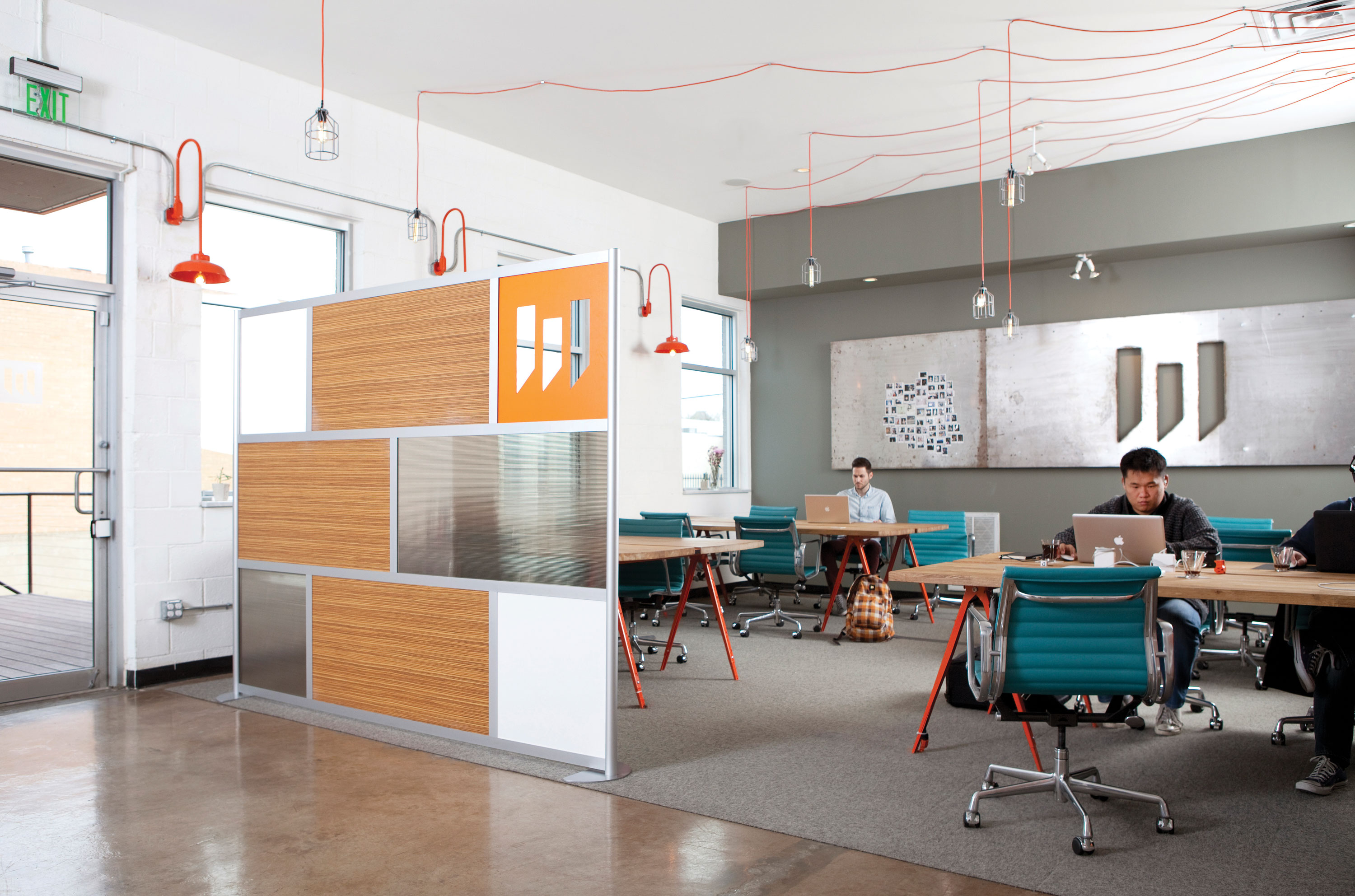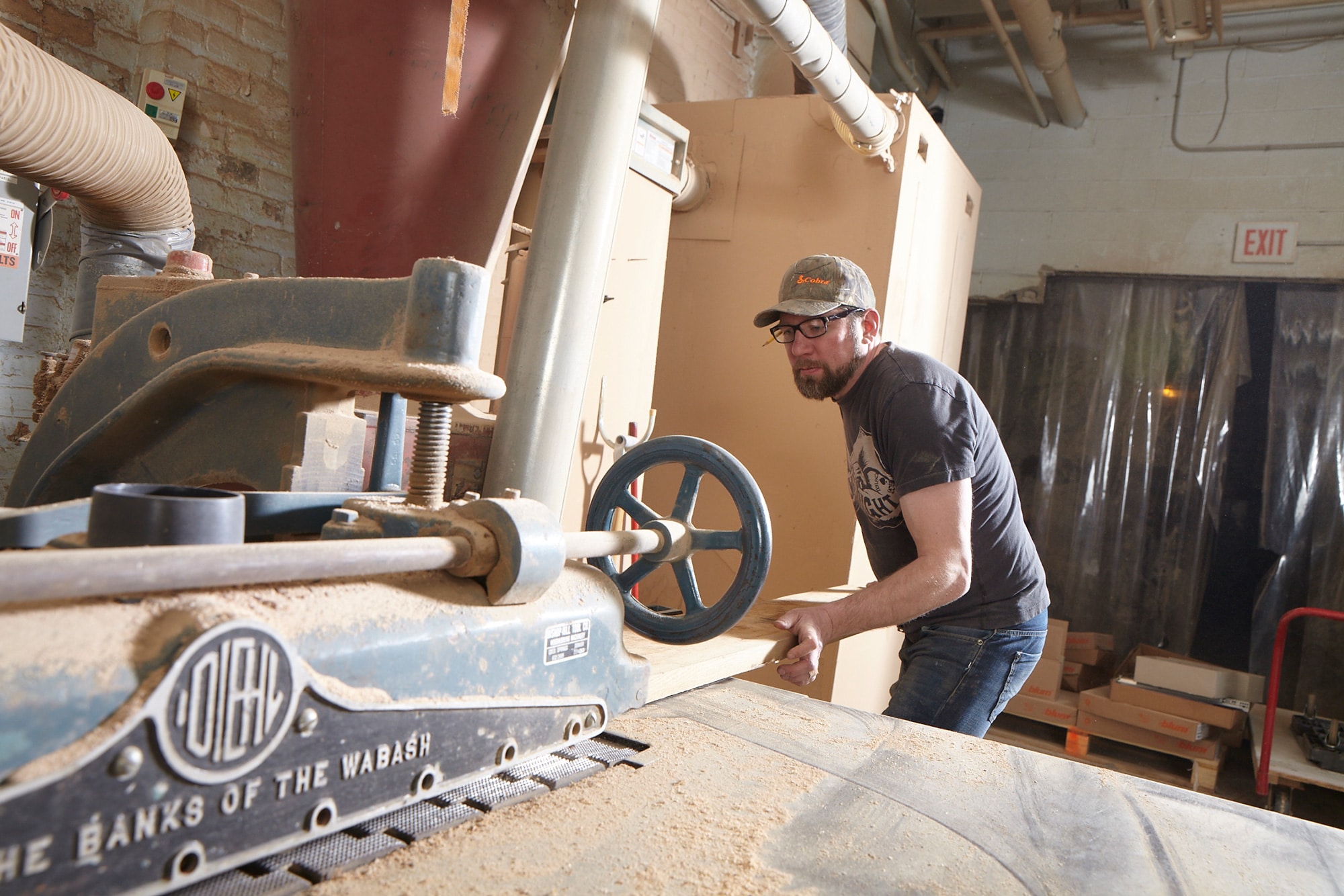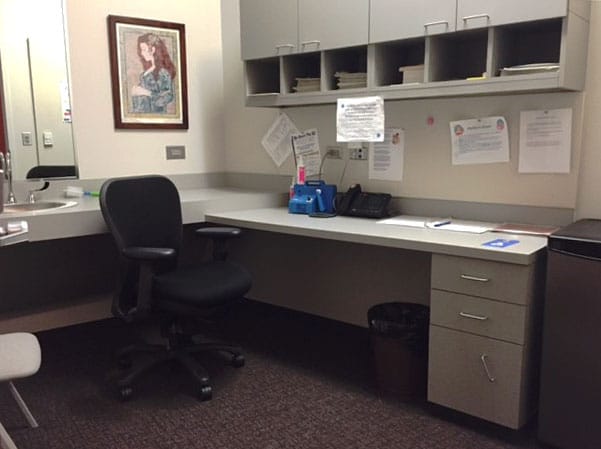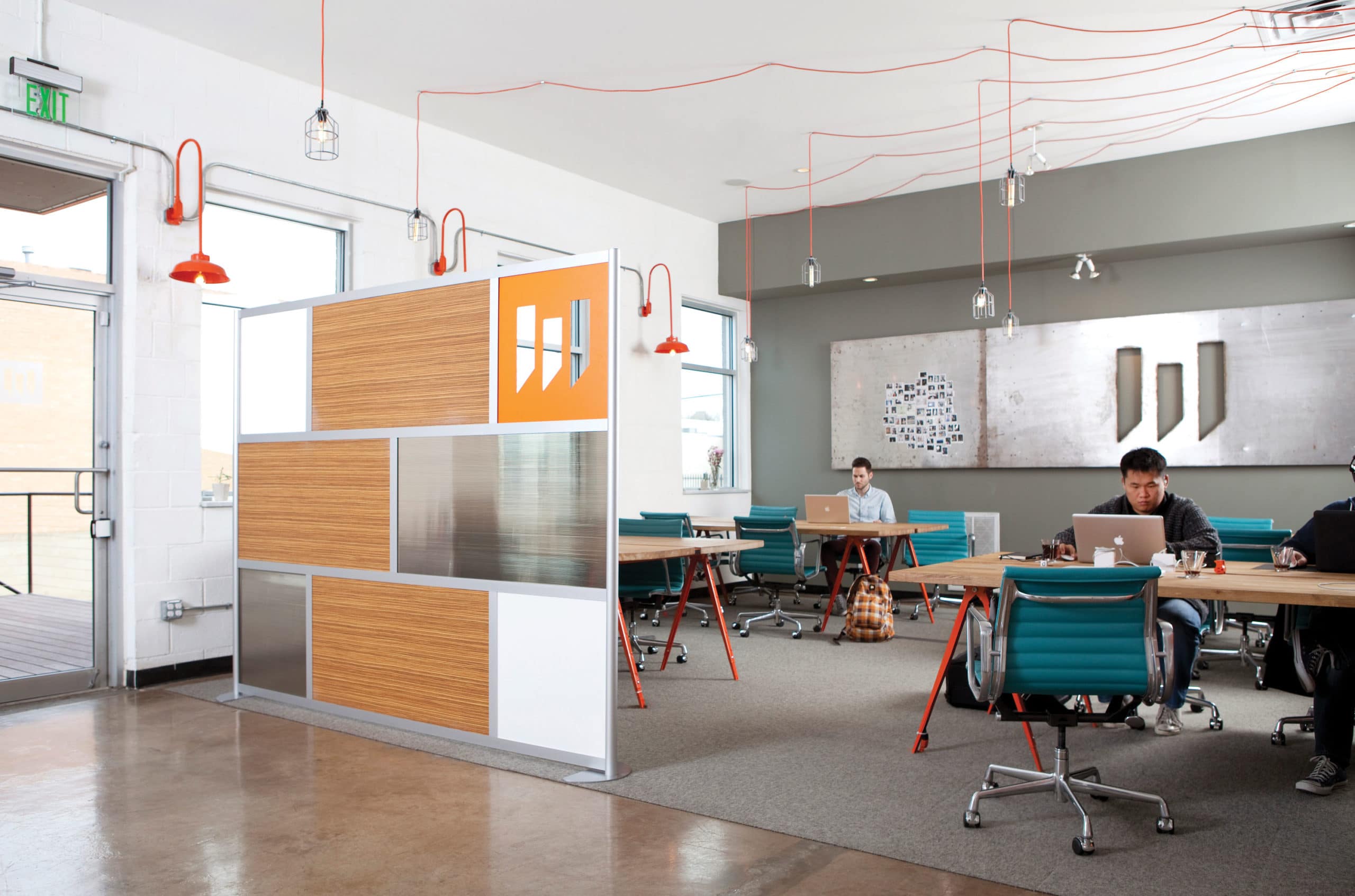“When we look at the workplace of the future, we’re actually evolving beyond that title—it’s the lifestyle of the future that we’re looking at,” Sargent says. “There is truly a blending between work and life.”
Let’s check out five design innovations that make workplaces healthier and more sustainable.

LOFTwall’s flexible, creative, and non-corporate-looking room dividers bring focus back to the workplace. [Photo: Justin Clemons]
1. Freestanding Room Dividers
The initial room dividers that Steve Kinder launched through his new company LOFTwall, started in Dallas in 2008, were intended for residential and loft-like spaces. It wasn’t until a couple years later when the company tapped into the office furniture industry and the rising need for open-office remedies that LOFTwall found its sweet spot in the market.
“Around 2012–2013, the whole open-office shift really started to take place and more designers and companies started looking for partitions,” Kinder says. LOFTwall’s freestanding room dividers emerged as a tool for these companies to optimize their open offices without having to resort to the fixed, compartmentalized architecture of the past. “People still need delineation of space and a sense of perceived privacy. They want visual barriers to divide their spaces without having to build walls.”
Across its product line, the company takes a design-forward approach through the use of bold colors, minimalist detailing, and unique finishes—avoiding the gray sameness that characterizes so much of what we’ve come to think of as office furniture.

Coterie’s custom office furniture makes for better workplaces. [Photo: Courtesy of Coterie]
2. Custom Office Furniture
One of the first things you’ll notice at Coterie’s Chicago studio is the impressive volume of custom furniture projects the husband and wife duo Jaime and Carrie Covert have going.
The couple started Coterie after Carrie, at the time in e-commerce and marketing, became exasperated with her job. Jaime suggested they build something together instead. “She knew how to build a marketing plan, and I needed a business partner,” he says. Now in their third year of business, the couple is busier than ever, adding to their robust portfolio of restaurants, hotels, retail spaces, and offices in Chicago and around the U.S.
“I love building gigantic conference tables,” says Jamie. “I think every office should have one.” Another way to cheer up an office? A sense of community. “Jaime’s built a lot of kitchen islands for offices lately so a team can enjoy lunch together,” Carrie says. “A lot of offices are very old-school with cubicles where you can hear a pin drop,” Jaime says. “I love when you can hear people and it’s very lively—huddle tables, conferences tables, somewhere to meet and share ideas.”

Elkay’s ezH2O filtered bottle filling stations offer fresh, clean water on-the-go. [Photo: Courtesy of Elkay]
3. ezH20 Bottle Filling Stations
Fresh, clean water is the cornerstone of human health. Elkay, a leading US-based manufacturer of bottle filling stations, offers an easy way for buildings to feel confident that the drinking water they offer to staff and guests is safer for consumption with their ezH2O filtered bottle filling stations. ezH2O’s point-of-use filters remove contaminants such as lead in compliance with the NSF/ANSI Standard 53. With a digital display that monitors the useful life of the filter, prompting it to be changed whenever needed, ezH2O continues to offer easier ways for staff and guests to keep tabs on the water they consume.
You’ve likely seen bottle filling stations on college campuses, in yoga studios and office buildings, where their bright green displays tally up how many plastic containers have been diverted from the waste stream. The technology has been made popular over the past six years, where their efficiency in filling reusable containers reigns supreme to the water fountain.
But Elkay’s ezH2O filtered bottle filling stations don’t just save water and encourage the use of reusable water containers, they also filter over 99% of the lead in water based on certification test results. Beyond already diverting much plastic waste from landfills and economizing clean, chilled water, these stations also help lower energy bills and shrink carbon footprints. When it comes to green or sustainable design and the safety of our waterways, bottle filling stations are a no-brainer. And the more we see of them on our daily commute, the more likely we are to take one more small and mighty step toward a sustainable future.

A lactation room goes a long way for working mothers. [Photo: Courtesy of Liz York]
4. Lactation Rooms
Storage rooms, closets, and bathrooms used to be the only choices for nursing mothers at work. As an architect and sustainability leader at the Centers for Disease Control and Prevention (CDC), Liz York set out to change the built environment for the better through wellness-based design. She worked with universities, architects, and lactation experts to author the American Institute for Architects (AIA) Best Practice Guide for Lactation Rooms.
“Our job as architects is to assess the built environment and adjust it to create buildings that protect the health, safety, and welfare of occupants,” says York. CDC’s lactation support program began in 1996 with one lactation room in Atlanta. Today, the program offers 34 lactation rooms at 13 campuses, and more than 4,000 staff have used the program. The rooms include a Medela pump, table, comfortable chair, footstool, towels, and a sign-in sheet. Most importantly, working moms have a quiet, private place, free from interruption.
“Just as the CDC is the steward of health for the U.S., the building and design community is the steward for health in the built environment,” says York. “Architects and designers need to continue to examine the way design impacts and inspires people to improve buildings, communities and our health.”

LivePanels by Suite Plants are designed by horticulture experts and engineered to be simple. [Photo: Courtesy of Suite Plants]
5. Green Walls
Suite Plants works with architects, interior designers, and contractors to set up and maintain customized green plant walls for both indoor and outdoor spaces.
Living Walls found inside have shown to increase worker productivity. Texas A&M University conducted a study that showed workers in greener conditions generated 15% more ideas. Incorporating a Living Wall in your office or workspace could increase employee productivity as an added bonus to a pleasing green aesthetic.
Sustainable rating systems such as LEED, the WELL building Standard, and the International Green Construction Code (IgCC) have recognized Living Walls in varying degrees as a product to make living spaces more green and sustainable. Living Green Walls also can dramatically reduce air pollutants such as carbon dioxide, volatile organic compounds, and also prevent illnesses caused by poor air quality.

